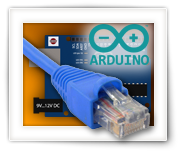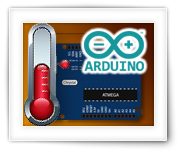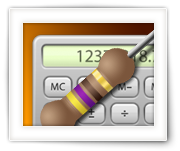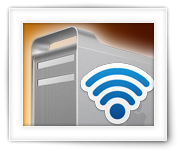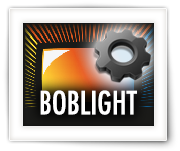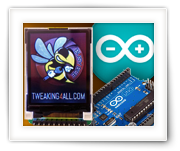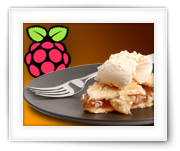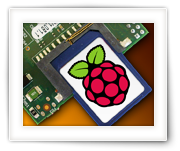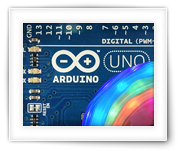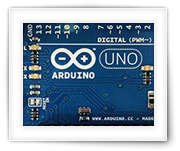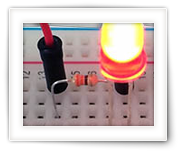In a previous article, I demonstrated how to use “Data Pull” to read sensor data over a computer network using an Arduino ENC28J60 Ethernet shield/module and some sensors (DS18B20 for example). In this article we will do the opposite: Data Push.
This means that we will make the Arduino send data to our server, which stored the results in a database. For this we will use an Apache, MySQL and PHP setup, which can be a full-size web-server or an easy to install “WAMPServer” setup on your desktop or laptop computer.
Some basic experience with PHP and web-servers will be helpful when working your way through this article.
Ad Blocking Detected Please consider disabling your ad blocker for our website.
We rely on these ads to be able to run our website.
You can of course support us in other ways (see Support Us on the left).
Playing with the Arduino is definitely fun, specially when you start looking into fun little add-ons like the Arduino ENC28J60 Ethernet shield/module we will looked.
Now sending a “Hello World!” message might be cool, but it’s hardly functional and since the Arduino is great with all kinds of sensors (like the DS18B20 temperature sensor), why not combine the two to retrieve Arduino Data over a network connection? With that comes the question … how the heck do I get my data? Obviously the “see it my web-browser” is one option, but how about a server application that is to store the sensor data?
In this article we will look at a trick we can use to “Pull” data to our server, server-application or even web-browser. This is probably the easiest way to get your data.
One day I ran into this particular Arduino ENC28J60 Ethernet module on eBay for $18. It included an Arduino ENC28J60 Ethernet shield/module and an Arduino USB Nano V3.0. Well, that’s pretty much for free isn’t it? So I could not resist and bought it, fully well knowing that it might not work. It took a little bit of figuring out, but I finally got it to work.
Playing with the Arduino is definitely fun, specially when you start looking into these kind of fun gadgets (snoop around on eBay and Amazon to see what’s out there!). If you look at eBay, or for example Amazon, for an Arduino ENC28J60 Ethernet shield, then you’ll notice that there are plenty models variations.
In this article we will focus on selecting a good ethernet library for the ENC28J60 and run a “Hello World” example.
The code discussed in this article will probably work for all of them.
In this example project we will be combining an Arduino and a DS18B20 temperature sensor.
The DS18B20 is a so called 1-wire digital temperature sensor. The words “digital” and “1-wire” make this sensor really cool and allows you, with a super simple setup, to read the temperature of one or more sensors. You can even connect multiple devices together, utilizing only one pin on your Arduino.
The more I play with the Arduino, the more fun it gets  …
…
Ad Blocking Detected Please consider disabling your ad blocker for our website.
We rely on these ads to be able to run our website.
You can of course support us in other ways (see Support Us on the left).
This Resistor Color Calculator allows you to enter resistor color codes to determine their Ohm-age (value), but it also works the other way around allowing you to enter the desired Ohm-age to find out what the needed color codes for the resistor should be.
I’ve had this one on all my old websites since way back in the day … but I do find myself going there often when I’m playing with electronic projects.
At some point I figured, it could use an update and it should probably get a home at Tweaking4All as well.
The updated version can now also calculate with 5 band resistors.
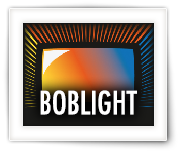
Back in the day, when the first LED TV’s appeared, Philips came with a great feature: Ambient TV lighting.
Ambient TV lighting consisted out of lights that would project to the wall behind your TV, one or more colors matching the content on your TV. So if the majority of the screen would be red, then the light emitted would be red, if the majority of the screen is green, then green light would be emitted, etc.
Over the years this has been refined to multiple colors, matching small parts of the screen. Unfortunately though, this wonderful feature is not something you can simply add to your TV. You will have to buy a Philips TV with this feature, …
Until now though, and only for XBMC (Kobi) users. Some smart guy(s) created Boblight, which is opensource and can run (for example) on your XBMC computer. The computer analyzes the video content and “converts” it to signals for LED strands, so you can attach these strands behind your TV and have a DYI Ambient TV lighting effect.
Note : This will only work for content played through your XBMC Media player (I used OpenElec)! So your regular TV shows, your XBox or PlayStation, none of these will have an influence on the “Ambient TV lighting” we will be discussing in this article.
I just installed a WiFi card in a Mac Pro and thought I’d share the ease of installation on my website. In my case, I installed it in my pride and joy, a 8-core Mac Pro 2008 model (Mac Pro 3,1) which kicks ass, but it works on newer models as well. As long as it’s a a model before the new late 2013 model (the fancy trash bin).
For this WiFi upgrade I used the Apple MB363Z/A Airport Extreme Wireless Upgrade Kit, found at Amazon new for $25, which MacOS X recognizes instantly – so no need for crazy drivers and weird WiFi apps. The Mac Pro, made out a metal alloy, has two build in WiFi antenna’s and this setup will pick up on 2.4Ghz and 5Ghz WiFi (if the same card is being used).
Ad Blocking Detected Please consider disabling your ad blocker for our website.
We rely on these ads to be able to run our website.
You can of course support us in other ways (see Support Us on the left).
When I started building my own “AmbiLight” project, based on OpenElec (XBMC) and Boblight, the first problem I ran into is finding a tool to create a Boblight config files for use under MacOS X. Naturally, there are quite a few great tools out there that do a good job, but it’s either a script, web-based or limited to Windows users (Boblight Config Tool), and again … not for MacOS X …
Creating a config file for Boblight can be quite tedious when you have a large amount of LEDs (I had 290 LEDs), when you mix up the orientation of your LEDs (pretty common issue), or when you do not have your LEDs spread out evenly.
So here is my tool, for Windows, MacOS X and Linux, written in Lazarus Pascal – enjoy!
UPDATE: Another minor bug fixed, added test video and Boblight Config Maker can now also be found at Alternativeto.net.
In this article I’ll show you how I connected a SainSmart 1.8″ Color display to my Arduino Uno and I’ll show you how to get some basic things to work.
The Arduino does not come with a display, and that’s perfectly fine as it’s intended to be used as a micro-controller and not a micro-computer.
Adding a display however, may be needed at times though to provide user feedback for when a user is using your marvelous Arduino invention.
User feedback can be done in several ways of course: a simple beep, a simple LED, a simple LCD screen, or like in this case, a more advanced Color Display.
Considering the price I decided to get one ($20 at Amazon, $13 at SainSmart, starting at $13 on eBay, or an Arduino version at AdaFruit for $20) and experiment with it.
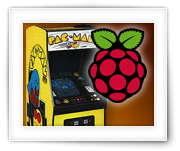
The Raspberry Pi is one fun little computer perfectly capable of emulation Classic Computers like the Commodore 64, ZX-81, ZX-Spectrum, Apple ][, Atari ST and even DOS/Windows 3.1. Emulation on the Raspberry Pi however is not limited to classic computers. Emulation of Classic Game Consoles like the Atari 2600, SEGA Genesis, Super Nintendo, Nintendo Entertainment System (or: NES) and Gameboy handheld work great as well.
My favorite in this however remains the emulation of classic Arcade Games with MAME.
Unfortunately, I did not find an emulator for one of my childhood consoles, the Magnavox Odyssey² (a.k.a. Philips VideoPac G7000).
In this article an introduction to CHAMELEONPI, an awesome distribution by Carles Oriol, which can be downloaded for free. It offers all of these emulators, with a beautiful interface and an easy way to upload ROMs and applications for the Classic Computers, Game Consoles, and Arcade Emulator (MAME).
Ad Blocking Detected Please consider disabling your ad blocker for our website.
We rely on these ads to be able to run our website.
You can of course support us in other ways (see Support Us on the left).
After writing the article on “How to get an Operating System on a SD-Card“, I realized that the existing methods and tools were not to my liking. Of course the existing tools are most certainly not bad and work just fine. I just didn’t like how they worked.
So instead of complaining, I decided to write my own program: The ApplePi-Baker  …
…
This application is for MacOS X only and allows you to prepare an SD-Card for use with Raspberry Pi’s NOOBS, and it allows you to “flash” and IMG file to an SD-Card. ApplePi-Baker can now also be found on AlternativeTo.net and eLinux.org.
Note : This application is also very suitable for creating or restoring an IMG backup of USB drives!
Update : ApplePi-Baker v2 has been released, you can get it here.
The new version offers a lot options including shrinking and expanding of IMG’s, writing to multiple disks, a better speed and improved stability compared to the old version (1.x) mentioned in this article.
When I first started working with the Raspberry Pi just after the first model A was released, my first issue was: How to get an Operating System on an SD-Card?
I mean: you just purchased a Raspberry Pi – you want to see it in action right away right?
After figuring that out, others have asked me the same question on how to create a SD-Cards for the Raspberry Pi. So here a guide on how to get it done in a few simple steps for Windows, MacOS X and Linux.
The Raspberry Pi, for those unaware, is a $35 computer, equipped with all you need (network, USB, etc), capable of running an Operating Systems like Linux, RiscOS, etc. and can even run XBMC (OpenElec for example) out of the box producing 1080p video through HDMI.
The main reason why I bought my first Arduino board was to be able to play with LED strips with applications like BobLight and LightPack that offer colored backlighting to your TV comparable to what Philips offers with it’s beautiful AmbiLight TV’s.
I like really Philips, and I like Ambilight, so why not buy a Philips AmbiLight TV?
Well, pretty simple … first of all Philips does not carry 80″ AmbiLight enabled TV’s, smaller models are significantly more expensive than non-AmbiLight models, and it appears that these AmbiLight TV’s are hard to find in the US.
In this article we will be using an Arduino Uno connected to a strip of WS2812/WS2811 LEDs.
Ad Blocking Detected Please consider disabling your ad blocker for our website.
We rely on these ads to be able to run our website.
You can of course support us in other ways (see Support Us on the left).
I recently aquired an Arduino UNO from Amazon, which can be had under $15 and for a few bucks extra you can get a nice starters kit with Breadboard, jumper wires and some components to play with.
To get familiar with an Arduino I ran my first basic project which switches an LED on and off. The good thing is that this first tiny project get’s you familiarized with the Arduino development tools, how to hook your Arduino up to your computer, and some very basic programming (C/C++ based).
When I started my first experiments with electronics, solderless breadboards, in Europe anyway, were not very common or at least not cheap.
Instead me and my dad wired everything together (the good old times!). We either used air to old everything together for the simpler designs, or we used an Open Hole Board PCB (a.k.a. Prototype PCB) for the more complex designs.
Once our design was completed and working we either left it as is – a bundle of components and wires soldered together – or we made a nice PCB to accommodate the components and connections. With Breadboards we’re only looking at the initial prototype …
Breadboards allow us to make our initial prototype much easier and much cleaner, and when I started dabbling with MicroControllers (BASICStamp) it became obvious that creating prototypes with Breadboards was the best way to go – even if it’s just to be able to handle the more expensive components more careful.
In this article a brief into to Solderless Breadboards.

